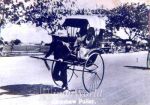We've tried to ensure the information displayed here is as accurate as possible. Should there be any inaccuracies, we would be grateful if you could let us know at info@ipohworld.org . All images and content are copyright.
(Please click on the thumbnail for a bigger image.)
The Rickshaw Puller And History Of The Jinricksha (Rickshaw)

The picture shows a rickshaw puller on the street. He is carrying two passengers. He is dressed traditionally in his coolie hat and is bare-footed.
The first rickshaws or jinricksha, to give it its proper name, originated in Japan. Accounts of their invention vary. Some favour an American Baptist Missionary in Yokohama, Jonathan Goble, who came up with the idea as a means of transport for his invalid wife. He drew a plan of it intending to have it manufactured and entrusted the blueprint for this novel device to one Shimooka Renjo. Renjo, is today better known as the father of Japanese photography, but at that time he was operating a horse-drawn-omnibus service between Tokyo and Yokohama. Unfortunately, he lost, or misplaced, the blueprint, but a short while later a vehicle, very like the one in Goble’s blueprint, was manufactured in Tokyo.
Naturally, the missionary blamed Renjo, but it seems that the Tokyo conveyance was a quite independent invention, a collaborative effort involving a chef, a greengrocer and a cartwright. Their principal motivation, it seems, was to avoid the extortionist practices of local palanquin-bearers, who were not beyond assaulting their passengers if they didn’t provide an adequate tip.
Whoever came up the original idea, it was the Tokyo three who applied for a licence to manufacture their ‘man-powered car’ which is the literal meaning of jinrikisha, in 1870. Within two years, there were around 25,000 of them plying the streets of Tokyo.
The first rickshaws arrived in the Straits Settlements in 1880. They were instantly popular and soon were competing strongly against the gharry as a local taxi service, which they eventually replaced altogether by around the turn of the century. There were two types, first-class single-seaters and second-class two-seaters. The latter were gradually phased out after 1911 on account of the great strain it put on the puller’s health.
The owners were towkays. The average rickshaw cost $35 in 1898 and they were imported from Japan. The Japanese vehicles suffered from wooden wheels, but when Malaya’s rubber industry took off in the first decade of the new century, an early benefit was the manufacture of rubber tyres for rickshaws. This began in 1904 and significantly improved their comfort.
The Japanese, as well as having invented the rickshaw were also responsible for its demise, when they strongly favoured the trishaw in Malaya during the Japanese Occupation, as they felt that the latter was smoother, faster, and less demeaning to the rider. Nonetheless a few rickshaws were still plying the streets of Old Town, Ipoh in the early 1950’s.
To read about Ipoh's Trishaws, click here.
To read about the history of Ipoh's transport in e-Book form, click here.